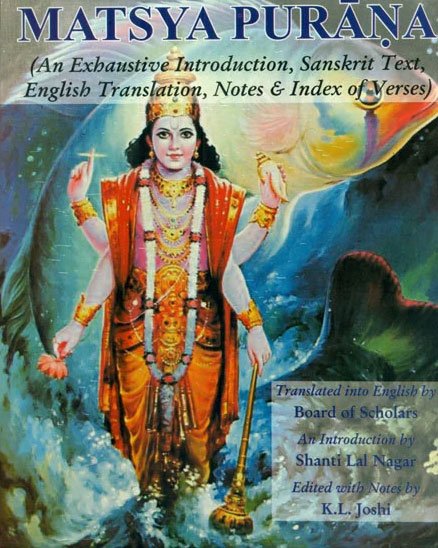The Matsya Purana (critical study)
by Kushal Kalita | 2018 | 74,766 words | ISBN-13: 9788171103058
This page relates ‘Different names of Vishnu’ of the English study on the Matsya-purana: a Sanskrit text preserving ancient Indian traditions and legends written in over 14,000 metrical verses. In this study, the background and content of the Matsyapurana is outlined against the cultural history of ancient India in terms of religion, politics, geography and architectural aspects. It shows how the encyclopedic character causes the text to deal with almost all the aspects of human civilization.
Part 1.1 - Different names of Viṣṇu
The Matsyapurāṇa has mentioned various names which are attributed to Lord Viṣṇu.
Out of these names a few are mentioned here, e.g.,
- Nara,
- Narottama,
- Jagaddhāma,[1]
- Bhagavān[2],
- Vāsudeva,[11]
- Janārdana,[15]
- Hṛṣīkeśa,[16]
- Mahīpati,[17]
- Lokanātha,[3]
- Madhusūdana,[4]
- Hari,[5]
- Nārāyaṇa,[6]
- Akalmaṣa,[7]
- Govinda,[8]
- Dāmodara,[9]
- Murāri,[10]
- Narāgraja,[12]
- Keśava,[13]
- Puṇḍarīkākṣa,[14]
- Sarvātmā,[18]
- Garuḍadhvaja,[19]
- Acyuta,[20]
- Adhokṣaja,[21]
- Vaikuṇṭha,[22]
- Yajñamaya,[23]
- Padmanābha,[24]
- Pradhāna Puruṣa,[25]
- Pradhānātmā,[26]
- Vajranābha, [27]
- Śrīvatsadhārī,[28]
- Puruṣottama,[29]
- Jagannātha,[30]
- Yajñeśa,[31]
- Jagatpati,[32]
- Yajñapuruṣa,[33]
- Prajāpati,[34]
- Paṅkajanetra,[35]
- Paṅkajanābha,[36]
- Ātmayogī,[37]
- Viśvapati[38] etc.
Lord Viṣṇu is known as Nārāyaṇa.[39] The Matsyapurāṇa mentions that the word nārāyaṇa is made of two words, viz., nara and ayana, which means he who lives in waters.[40] He is described as Pītavāsa, having yellow garments.[41] He holds the weapons gadā[42] and cakra[43] in his hand and therefore he is called Cakrin[44] and Gadābhṛt.[45] Lord Viṣṇu is also called Śrīpati and Śrīkānta[46] as Śrī or Lakṣmī is His consort.[47] Viṣṇu created from his thigh a paragon of beauty who came to be known in the world as Urvaśī. Interestingly, Viṣṇu in the Matsyapurāṇa, is also identified with Cupid. In Anaṅgadānavrata, Viṣṇu is worshipped with different names of Kāma.[48] In the Viṣṇuvrata[49] he is worshipped with the mantra kandarpāya namaḥ.[50] In the Madanadvādaśīvrata also,[51] he is worshipped with the names of Cupid.[52]
The influence of Pāñcarātra system is noticed in the Matsyapurāṇa as it refers to the four Vyūhas accepted in the Pāñcarātra system. In the history of Vaiṣṇavism, the Pāñcarātra school is deemed as the source of all Vaiṣṇava sects in India. One of the important features of this system is its Vyūha theory. The doctrine of Vyūha may be said to be the most salient and unique doctrines of Pāñcarātra cosmogony. The Vyūhas are the four emanations of Nārāyaṇa, viz., Vāsudeva, Saṃkarṣaṇa, Pradyumna and Aniruddha. Saṃkarṣaṇa is said to have emanated from Vāsudeva, Pradyumna from Saṃkarṣaṇa, and Aniruddha from Pradyumna.[53]
Pāñcarātras also maintain that each Vyūha has creative and moral functions. Śamkarsana destroys the world. Pradyumna subsists as the meaning of scriptures and preserves the created world. Aniruddha bestows the fruit of action to the worshippers and is in charge of the world.[54] The Matsyapurāṇa mentions these four Vyūhas and refers to their respective functions.[55] Vāsudeva is so called because all creatures including Brahmā reside in him at the time of the end of the yuga. Again He contracts the creatures repeatedly in every kalpa and as such He is called Saṃkarṣaṇa. He is named as Pradyumna because he is the knower of all dharmas. Aniruddha is so called because none is His obstructor.[56]
Footnotes and references:
[1]:
Ibid., 1.26
[2]:
Ibid., 1.5
[3]:
Ibid., 1.5 Ibid., 1.27
[4]:
Ibid., 2.1-2; 57.7
[5]:
Ibid., 16.45; 21.11
[6]:
Ibid., 16.45; 21.11 etc.
[7]:
Ibid., 24.26
[8]:
Ibid., 45.5,10
[9]:
Ibid., 54.11
[10]:
Ibid., 54.31
[11]:
The worship of Vāsudeva is recommended to remove the evil effects of doomed dreams. Ibid., 242.16; 1.24; 69.17; 93.51
[12]:
Ibid., 61.24
[13]:
Ibid., 69.31
[14]:
Ibid., 69.32; 99.5
[15]:
Ibid., 1.26; 21.12
[16]:
Ibid., 1.25; 69.35
[17]:
Ibid., 1.28
[18]:
Ibid., 99.9
[19]:
Ibid., 150.211
[20]:
Ibid., 150.241
[21]:
Ibid., 153.10
[22]:
Ibid., 153.14
[23]:
Ibid., 161.29
[24]:
Ibid.,170.23
[25]:
Ibid., 171.65
[26]:
Ibid., 172.7
[27]:
Ibid., 178.40
[28]:
Ibid., 178.28
[29]:
Ibid., 183.96
[30]:
Ibid., 246.36
[31]:
Ibid., 246.24
[32]:
Ibid., 246.37
[33]:
Ibid., 244.23
[34]:
Ibid., 244.27
[35]:
Ibid., 244.13
[36]:
Ibid., 244.13
[37]:
Ibid., 244.15
[38]:
Ibid., 244.27
[39]:
Ibid., 1.3
[40]:
Ibid., 248.42-43
[41]:
Ibid., 136.58
[42]:
Ibid., 1.10
[43]:
Ibid., 20.38; 268.57
[44]:
Ibid., 244.13
[45]:
Ibid., 244.20
[46]:
Ibid., 71.6
[47]:
Ibid., 23.24
[48]:
Ibid., 70.34
[49]:
Ibid., 99
[50]:
Ibid., 99.7
[51]:
Ibid.,7
[52]:
Ibid., 7.15; 20.25
[53]:
Ahirbudhnyasaṃhitā, 5.29-38
[54]:
Ibid., 5.20-24
[55]:
Matsyapurāṇa, 248.46 ff
[56]:
Ibid., 248.46 ff
